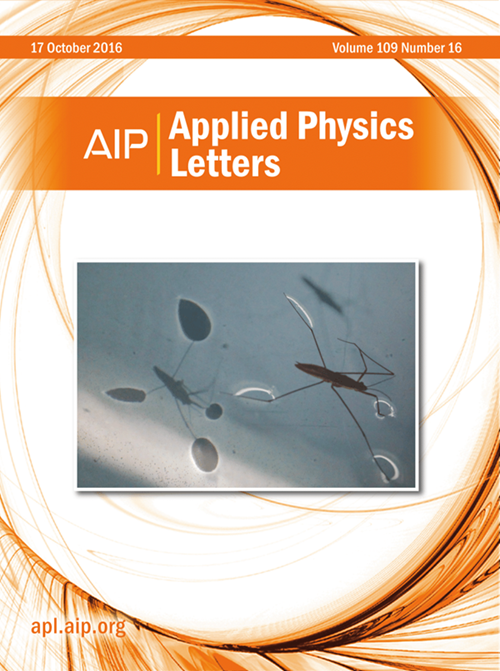利用高质量环形谐振器鉴定绝缘体上磷化镓平台的热光学系数
IF 3.6
2区 物理与天体物理
Q2 PHYSICS, APPLIED
引用次数: 0
摘要
表征材料的热光学系数为优化光子集成器件的热调谐奠定了基础,这是光通信、传感和信号处理应用的关键特征。与传统的体积测量不同,确定微尺度光子器件中的热光学系数(TOC)在数据处理方面具有显着优势,并且与实际器件性能更直接相关。在这项工作中,我们使用空气包覆环形谐振器来表征磷化镓(GaP)薄膜的TOC,该谐振器建立在绝缘体上的GaP (GaP- oi)结构上。该谐振器是通过优化的“蚀刻-n-转移”工艺制造的,该工艺采用二氧化硅硬掩模来提高图案转移的精度,提高波导表面清洁度,减少缺陷并确保更好的器件性能。采用接触光刻技术制备的谐振腔在1550 nm处的负载品质因子为(2.18±0.1)×104,波导传播损耗为23.8±0.3 dB/cm。在780 nm处,传输损耗降至16.7 dB/cm。该谐振器还显示出65.8 pm/K的温度相关波长位移,使我们能够为GaP提取1.19 × 10−4/K的TOC。这种高温度灵敏度使GaP-OI平台特别适合快速热车削,这有利于一系列应用,包括光传感、光信号处理和高效非线性转换。本文章由计算机程序翻译,如有差异,请以英文原文为准。
Characterizing the thermo-optic coefficient of gallium phosphide-on-insulator platform using high-quality ring resonators
Characterizing a material's thermo-optic coefficient lays the foundation for optimizing thermal tuning of photonic integrated devices, a key feature for applications in optical communication, sensing, and signal processing. Unlike traditional bulk measurements, determining the thermo-optic coefficient (TOC) in microscale photonic devices offers significant advantages in data processing and provides more direct relevance to real-world device performance. In this work, we characterize the TOC of gallium phosphide (GaP) films using an air-cladded ring resonator, built on a GaP-on-insulator (GaP-OI) architecture. The resonator is fabricated via an optimized “etch-n-transfer” process, which incorporates silicon dioxide hard masks to enhance the precision of pattern transfer and improve the waveguide surface cleanliness, reducing defects and ensuring better device performance. The fabricated resonator exhibits a loaded quality factor of (2.18 ± 0.1)×104 at 1550 nm by using contact lithography, with a waveguide propagation loss of 23.8 ± 0.3 dB/cm. At 780 nm, the propagation loss decreases to 16.7 dB/cm. The resonator also shows a temperature-dependent wavelength shift of 65.8 pm/K, allowing us to extract a TOC of 1.19 × 10−4/K for GaP. This high temperature sensitivity empowers the GaP-OI platform particularly well-suited for rapid thermal turning, which is beneficial for a range of applications including optical sensing, optical signal processing, and highly efficient nonlinear conversion.
求助全文
通过发布文献求助,成功后即可免费获取论文全文。
去求助
来源期刊

Applied Physics Letters
物理-物理:应用
CiteScore
6.40
自引率
10.00%
发文量
1821
审稿时长
1.6 months
期刊介绍:
Applied Physics Letters (APL) features concise, up-to-date reports on significant new findings in applied physics. Emphasizing rapid dissemination of key data and new physical insights, APL offers prompt publication of new experimental and theoretical papers reporting applications of physics phenomena to all branches of science, engineering, and modern technology.
In addition to regular articles, the journal also publishes invited Fast Track, Perspectives, and in-depth Editorials which report on cutting-edge areas in applied physics.
APL Perspectives are forward-looking invited letters which highlight recent developments or discoveries. Emphasis is placed on very recent developments, potentially disruptive technologies, open questions and possible solutions. They also include a mini-roadmap detailing where the community should direct efforts in order for the phenomena to be viable for application and the challenges associated with meeting that performance threshold. Perspectives are characterized by personal viewpoints and opinions of recognized experts in the field.
Fast Track articles are invited original research articles that report results that are particularly novel and important or provide a significant advancement in an emerging field. Because of the urgency and scientific importance of the work, the peer review process is accelerated. If, during the review process, it becomes apparent that the paper does not meet the Fast Track criterion, it is returned to a normal track.
 求助内容:
求助内容: 应助结果提醒方式:
应助结果提醒方式:


